Long-time readers know that This is True was created while I still had a Day Job. It was a very cool job: I was on the engineering staff at NASA’s Jet Propulsion Laboratory (1986-1996 — True was started in 1994, so there was a two-year overlap).
Shortly after I left to pursue True full time, a friend of mine there took over a public outreach program: the “Solar System Ambassadors” who help educate the public about what NASA (and JPL in particular) are doing.
Endless Frontier
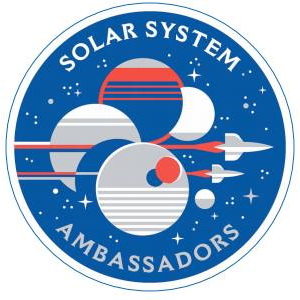 Kay reached out to me, and I’ve been an Ambassador ever since. It doesn’t change what I share with the public — I’ve been writing about space topics on the side anyway, but this way, I get some special access to make my reports to you even better, and Kay gets “outreach credit” for the people I reach: a nice win-win.
Kay reached out to me, and I’ve been an Ambassador ever since. It doesn’t change what I share with the public — I’ve been writing about space topics on the side anyway, but this way, I get some special access to make my reports to you even better, and Kay gets “outreach credit” for the people I reach: a nice win-win.
As a NASA Center, the Jet Propulsion Laboratory’s main mission is to manage the robotic (vs astronaut) exploration of the solar system, and beyond. They’re the ones that send probes out to other planets, and the rovers on Mars.
In 2012, the Curiosity rover, more formally known as the Mars Science Laboratory, landed on Mars. How do you safely land a 2,000-lb. (900kg) rover on the surface of another planet with a very thin atmosphere? With an audacious landing like this (5-minute summary):
Now, I really like working for myself, but if I “have to” have a Day Job, well, JPL is about the coolest place on Earth to work. I got to work with the kind of people who figured stuff like this out. I watched it live. Here’s what it looked like in Mission Control (2-1/2 minute summary):
Behind the Scenes
And all this ties together to explain why I was in California: that “special access” I get as an Ambassador turned into a behind-the-scenes, VIP tour of the Lab and what they’ve been working on lately, being briefed by the scientists who are working on the missions. The idea: to celebrate the Ambassador program’s 25th Anniversary, and brief the Ambassadors on what’s going on so we can all explain it to the public better. I also got to bring Kit; she’s bit of a science nerd too (hey: it’s one of the reasons why we got together!) Here are just a few of the highlights.
Welcome to the Solar System
They started us out in Mission Control. Just like there’s a Mission Control in Houston for the astronaut-led missions, there’s one at JPL for the robotic missions — as seen in the second video above. There’s a gallery window above Mission Control that I used to go to all the time: I’d always take visitors there to see it. But even as an employee, I never got to go inside Mission Control. On the VIP tour, we did:
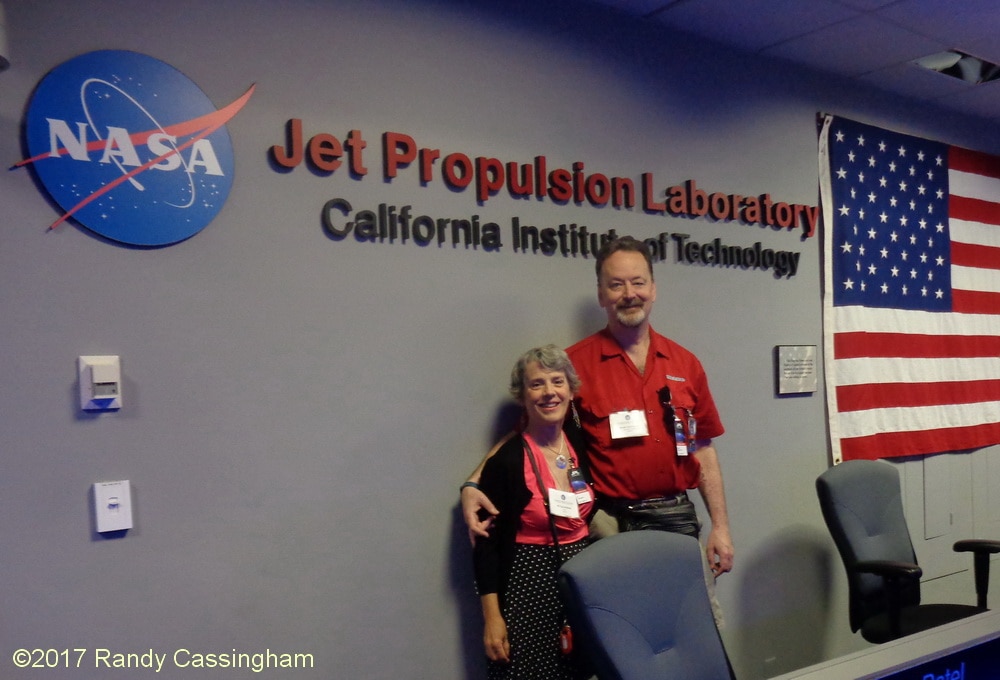
There are multiple spacecraft in the sky currently, and Mission Control is in operation 24 hours a day, every day. At JPL, it’s known as SFOF (which yes, they pronounce: “ess-foff”), for its more formal title: the Space Flight Operations Facility. It was built to support the unmanned (Ranger and Surveyor) missions to the moon in preparation for the Apollo moon landings. So it’s been running 24x7x365 since the early 1960s!
The on-duty engineers put up with all of us geeky types running around taking pictures:
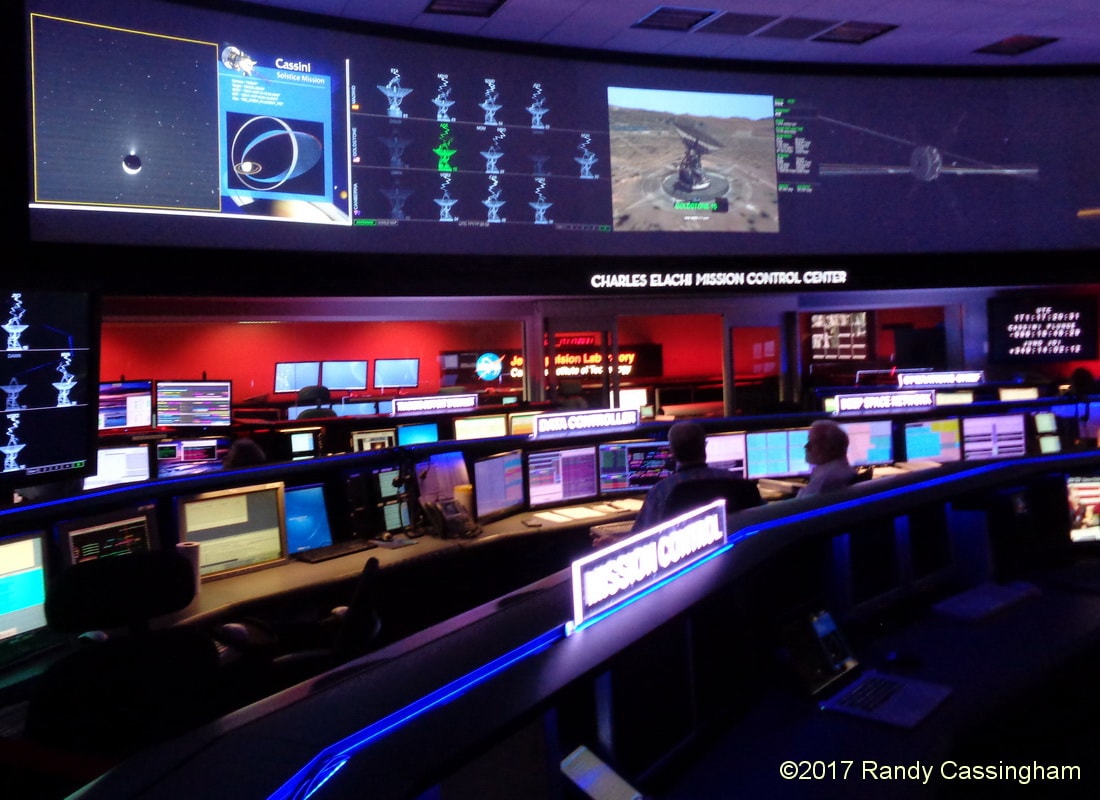
In that last photo, you can see what looks like big dish antennas with radio waves. To talk to spacecraft that are sometimes billions of miles away, you need a big antenna system. More on that in a moment.
Mars on Earth
We popped up to the “Mars Yard” to see where they test the rovers. There’s a full size copy of Curiosity there, so if the real rover gets into any sort of a jam, they can replicate what’s going on at JPL and decide how to get the rover out of that jam. Here’s the full-size replica:
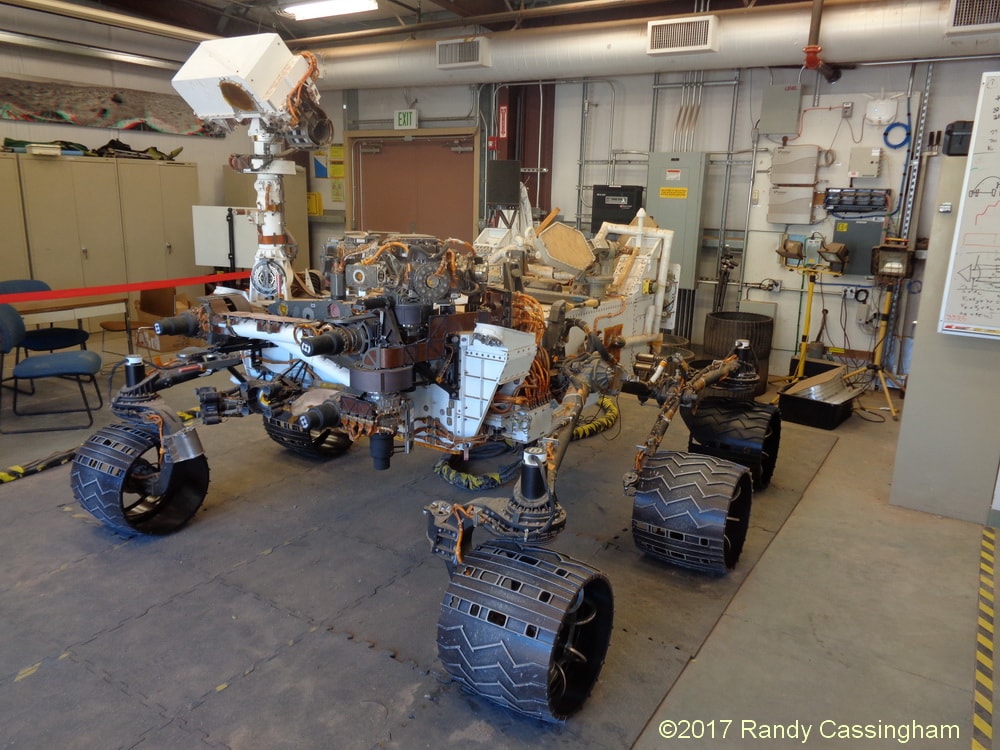
Notice the holes in the wheels? That’s not just to let dust out of the wheels as they turn. It’s hard to see here, but as they roll through the Martian dust, they stamp out a pattern. That helps create milestones for the cameras to get very specific measurements. It’s also Morse Code ( · – – – · – – · · – · · ) …which just happens (cough) to spell out “JPL”.
They didn’t start out with Morse Code: they started with regular letters as part of the treads, which you can see here, on an early version of the wheel:
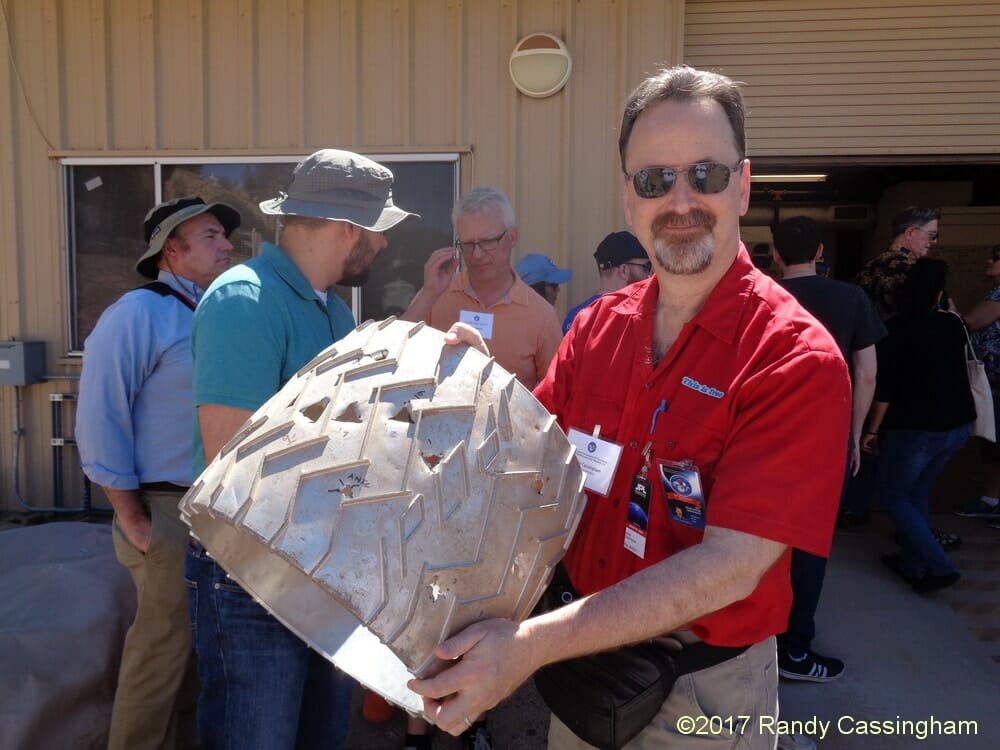
Note the holes punched into this wheel: that’s how they were able to tell they were making the wheels too thin. Six wheels support the rover’s 2,000-lb. (900kg) weight. Even though the gravity on Mars is less, and thus the weight isn’t as much there (about 750 lbs.), Mars rocks are known to be sanded by the winds into sharp points. When they ran these wheels over simulated Mars rocks, they punched through. They fixed that well before launch.
But that, as mentioned, wasn’t the only change in the wheels. When NASA headquarters saw the “JPL” on them, they said there’s no way they were going to allow JPL’s rover to stamp “JPL” all over Mars. That’s when the engineers got more creative, and came up with the Morse Code alternative.
The Next Mars Mission
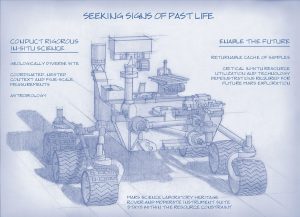
So Curiosity has been motoring around for five years now. What’s next? Mars 2020. You can read about that mission at the link (Wikipedia article), but here’s what I didn’t know about this new rover mission until we got a briefing from one of the engineers: it’s going to drive around Mars to gather samples from the planet. They’ll drill into things that look interesting, and then seal the samples into tubes. The engineer who was telling us about that has the job of figuring out how the rover itself will deposit the samples into metal tubes, and then seal them so there’s no possibility of contamination between Mars and Earth.
So the obvious question is, how the heck are they going to get the tubes back to Earth for analysis? Here’s the wild part: that’s beyond the scope of the Mars 2020 mission! The mission after that will have the job of following in the “footsteps” of the Mars 2020 rover, pick up the tubes that it dropped, and send them back to Earth! They don’t want all their mission eggs in one basket, so they’re making that a separate mission. Wild!
Here’s what the tubes look like:
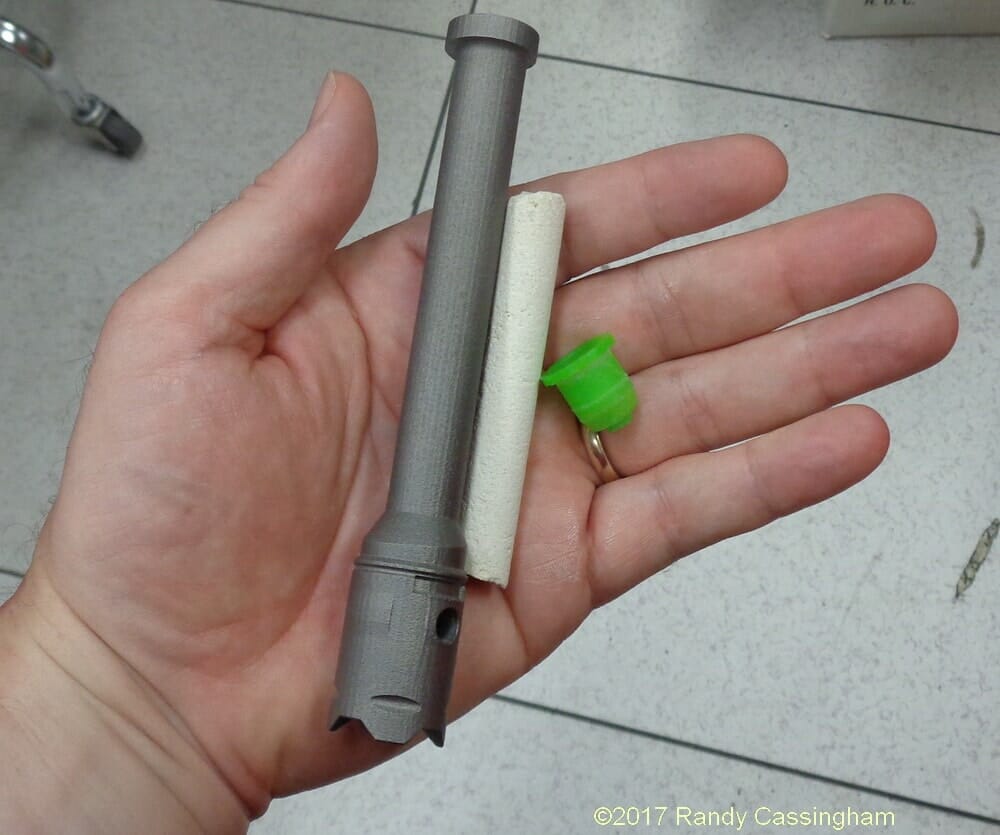
Once fully boggled by that, we then headed for the High Bay. To get there, we had to walk by the building where I had my first office:
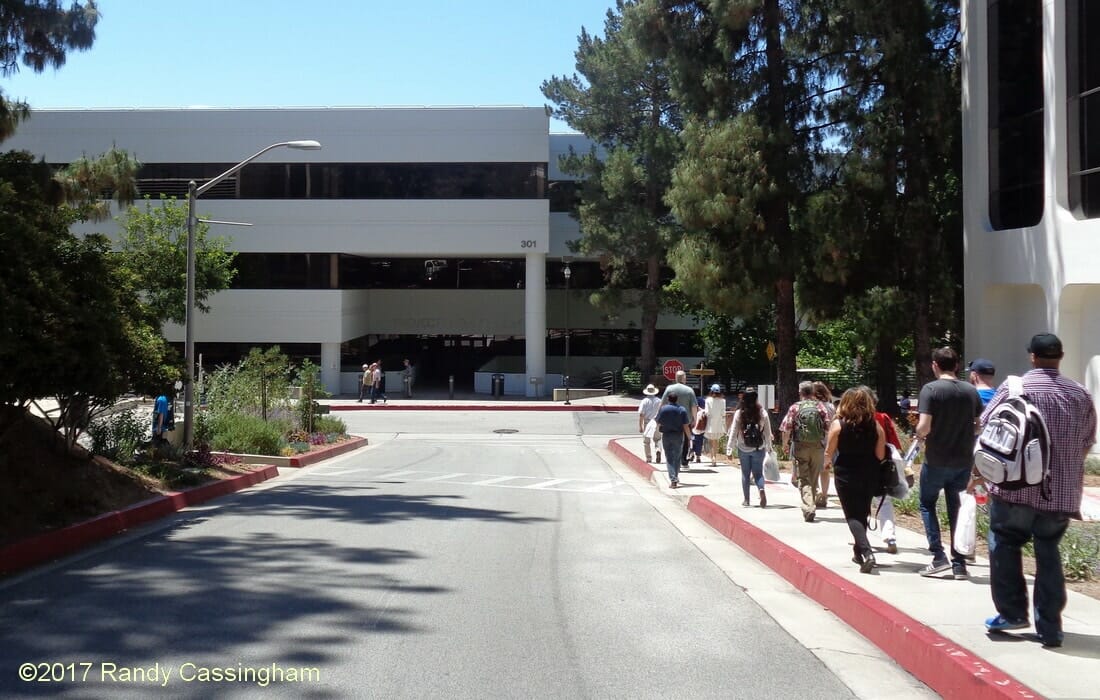
The High Bay is a giant clean room, where spacecraft are built. I used to go down there all the time during lunch to watch the Cassini spacecraft being built. It launched the year after I left (1997), and took seven years to arrive at Saturn, where it is still doing science …until September 15, 2017, when it will have a very decisive end of mission (details at the link).
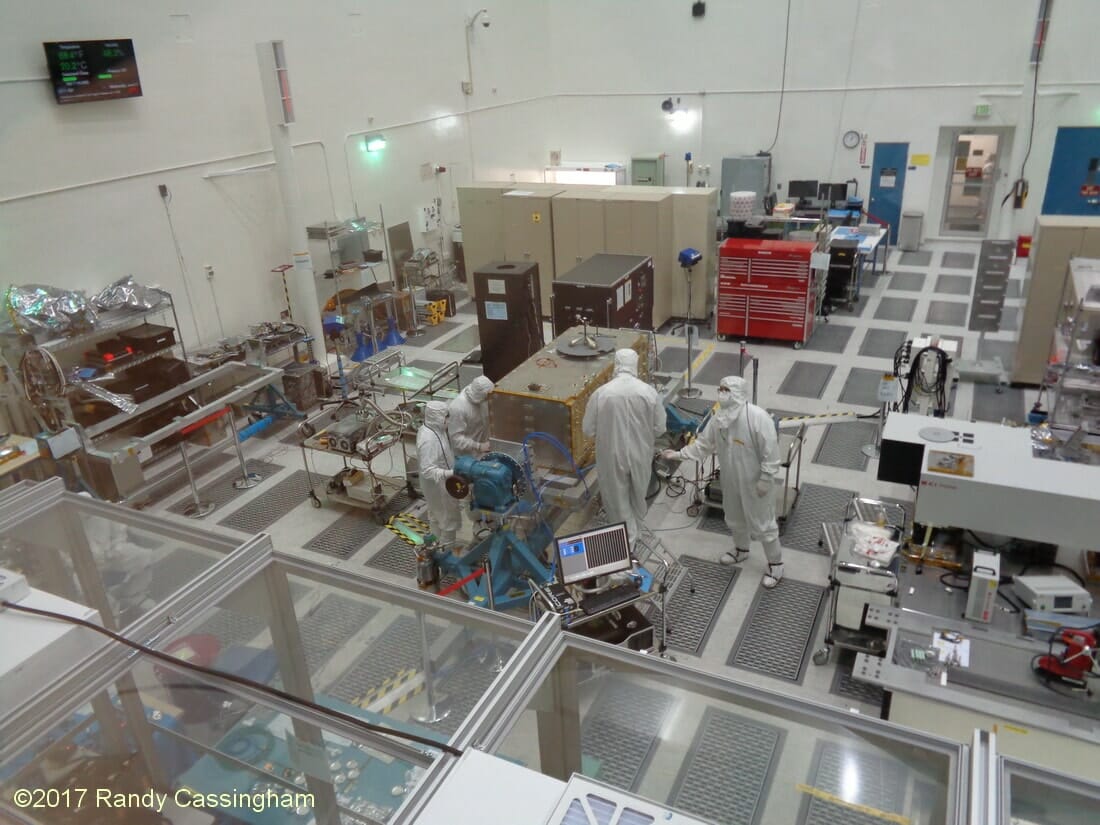
ECOSTRESS doesn’t have a Wikipedia page, but JPL has one for it. Briefly, it will measure the temperature of plants and use that information to better understand how much water plants need, and how they respond to stress, to answer three main science questions:
- How is the terrestrial biosphere responding to changes in water availability?
- How do changes in diurnal vegetation water stress impact the global carbon cycle?
- Can agricultural vulnerability be reduced through advanced monitoring of agricultural water consumptive use and improved drought estimation?
Getting All the Data Back
I mentioned above that the spacecraft JPL sends out can be billions of miles away. They’re not going out there just to go, they’re out there to do science, including sending back photos. We have to get the data and photos back …somehow.
The twin Voyager probes, launched in 1977, are the farthest away — specifically, Voyager 1 is the farthest. As of this writing, it’s about 12.85 billion miles (20.7 billion km) from Earth. It’s so far away that a radio signal, which travels at the speed of light, takes more than 19 hours to get there. Send a command and wait for a reply? Twice that for the round trip.
Then consider the transmitter power on the spacecraft is just 25 watts. The typical radio transmitter in a police car or ambulance generally puts out 50-75 watts of signal. (Power is very scarce on a spacecraft, so they use as little as they think they can get away with.) So if the spacecraft is putting out a feeble signal from very far away, how do you receive it? With a BIG antenna.
Because JPL is the lead NASA center for interplanetary spacecraft missions, it created and operates the Deep Space Network, which uses three ground stations around the world so that at any specific time, at least one of them can “see” any probe out in space. Those three ground stations are located in Madrid, Spain; Canberra, Australia; and the Mojave Desert in Southern California. So after a day of touring JPL’s main campus, the next day we drove out to the “Goldstone” tracking stations, which are located within the confines of the U.S. Army’s Fort Irwin, a major training base.
It was a fairly typical 112 degrees there (44.5C) that day. And oh, “You can’t wear shorts.” (The supposed reason: the rattlesnakes. Our suspected reason: the army brass don’t want the trainees to be too jealous.)
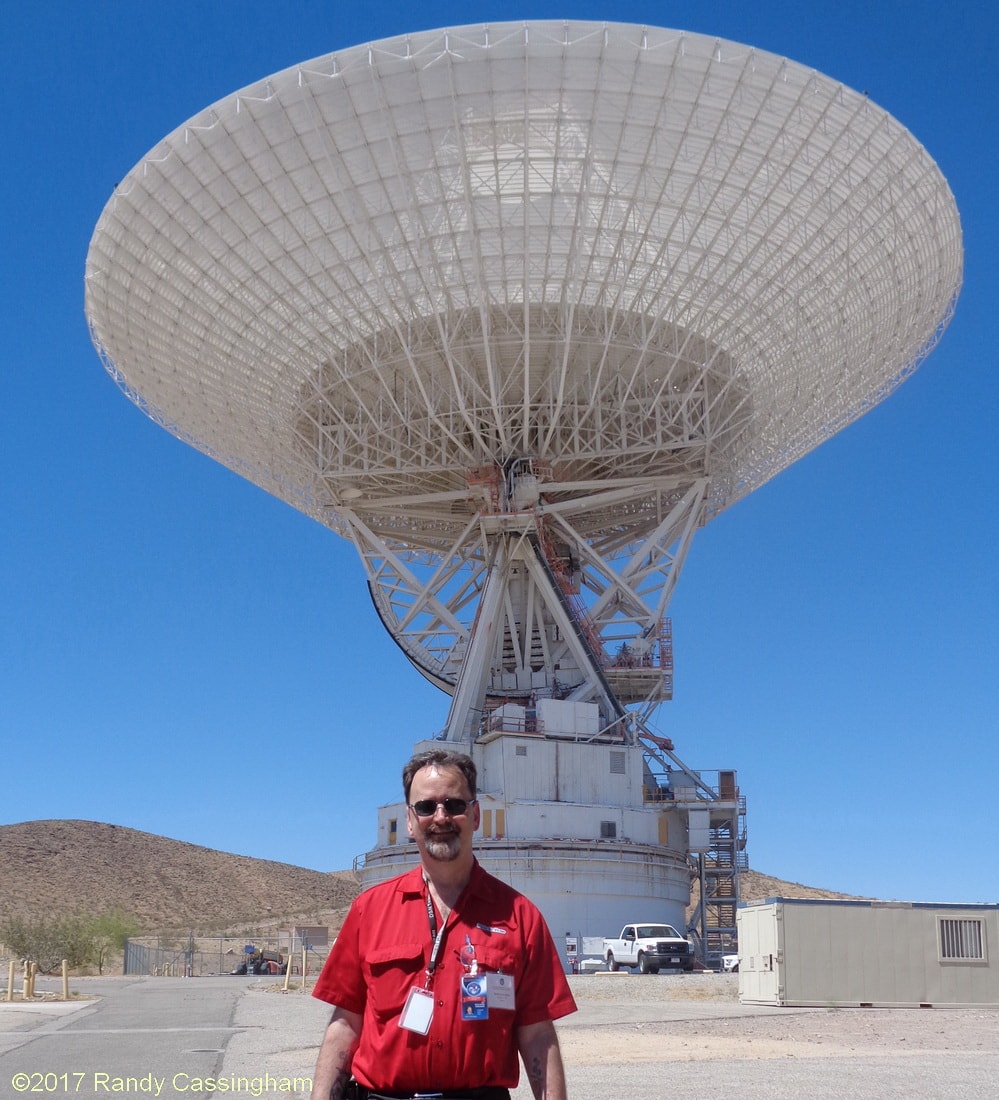
So now wrap your mind around this: the spacecraft is billions of miles away, and has a transmitter putting out less power than the light bulb in your refrigerator. So you have this huge antenna to receive that signal, but to do that it has to be really carefully pointed toward that spacecraft. So you not only have to know exactly where that spacecraft is, you have to point right at it. Which means that this antenna, which is 70m (230 feet) in diameter, not only moves, but very, very precisely!
I worked on a project for the DSN when I worked at JPL, and had been here before. We didn’t have to drive: since several of us were going, we got to fly on a NASA aircraft. (And we not only got to wear shorts, we were told to!)
That time, we went into the control room at the bottom of the dish. We could see the platform was turning, so we just had to be careful as we transitioned onto the stairs. We climbed up to the control room, got to see everything, and came back out. When we climbed on, the antenna was pointed up, as in this photo. When we came back out, it was pointed horizontally — a 90-degree movement. And we had no idea it was doing that — it was that smooth. Astounding.
Each of the three stations around the world has one of those big dishes. For less demanding communications (such as closer spacecraft), they have several smaller (34m) antennas at each station too. And consider that the Earth is spinning on its axis, so for a “long pass” (lengthy download), the antenna has to move constantly to stay directly pointed.
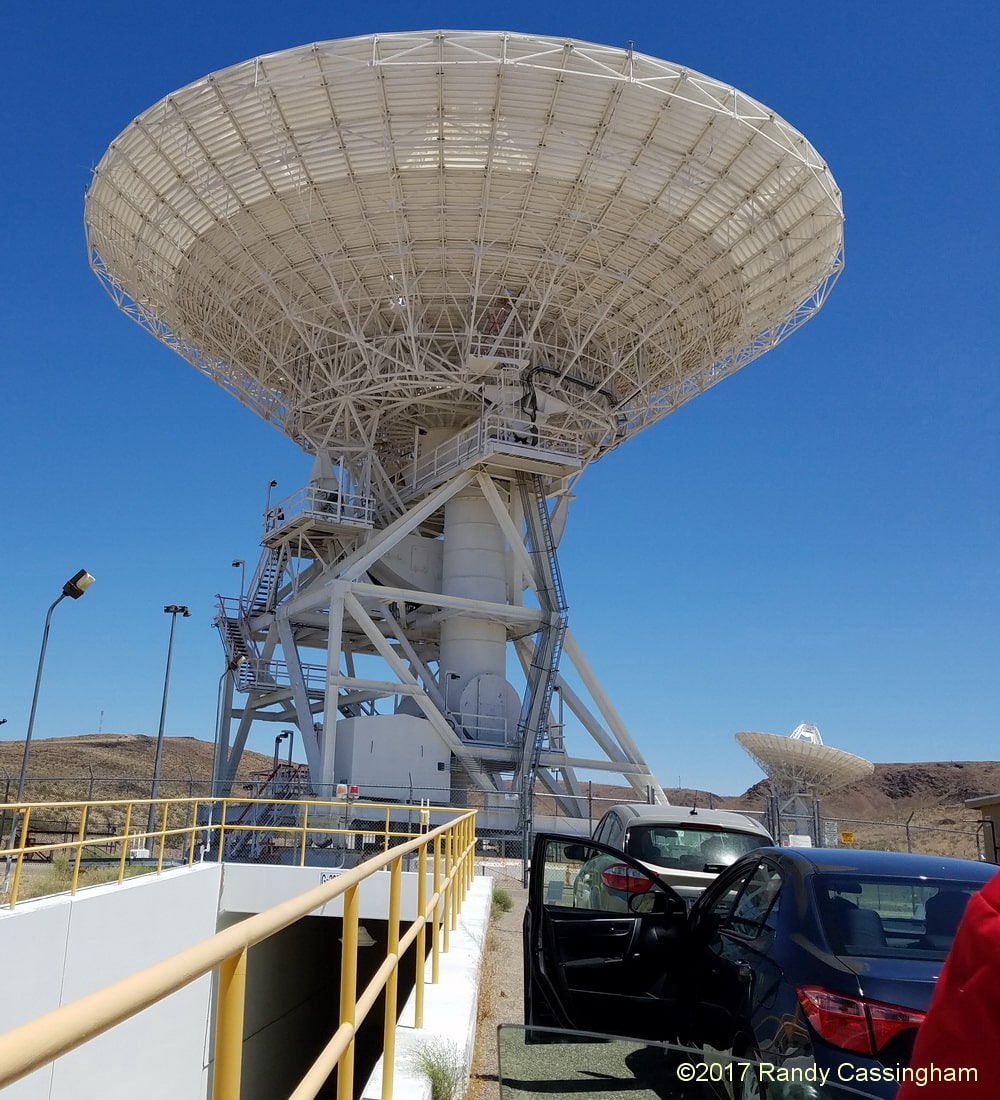
And that’s why we popped out to California. We Ambassadors soaked up a lot of new information to help explain things, which will certainly inform my upcoming space-related blog posts. (See the full menu of past space-related posts here.)
While I left JPL to work on True full time, it’s still in my blood — officially, even, as an Ambassador (thanks, Kay!) It was an amazing place to work, and I’m glad I’m still welcome back from time to time.
Related Post: International Space Station: 20 Years.
– – –
Bad link? Broken image? Other problem on this page? Use the Help button lower right, and thanks.
This page is an example of my style of “Thought-Provoking Entertainment”. This is True is an email newsletter that uses “weird news” as a vehicle to explore the human condition in an entertaining way. If that sounds good, click here to open a subscribe form.
To really support This is True, you’re invited to sign up for a subscription to the much-expanded “Premium” edition:
Q: Why would I want to pay more than the minimum rate?
A: To support the publication to help it thrive and stay online: this kind of support means less future need for price increases (and smaller increases when they do happen), which enables more people to upgrade. This option was requested by existing Premium subscribers.

Incredible, Randy! And you left why???
—
You live here too, Bill: you know why! Mountain views, clean air, and great weather. And yeah, I love this job, too. -rc
All kinds of cool!
How long do you think it will be before the mission to retrieve the soil samples from Mars?
I know that all sorts tests an experiments will need to be done for this, but do you think they will be able to figure out how long ago the water evaporated?
—
It’s actually more complicated than I mentioned — I thought the post was already getting long enough. The next mission would collect the samples and get them into Mars orbit, and a mission after that would get them from Mars orbit to Earth. Crazy! The problem is, the missions haven’t been approved yet, let alone funded. So it’s totally unclear when it might actually happen. Still, this is all about long-term planning, which is what helps lead to mission success.
As for water, the atmospheric pressure is too low to sustain liquid water now, but as you indicate, that wasn’t always the case. But there’s still plenty of water there: not just in the ground, but there’s enough water ice in the south polar ice cap alone that, if melted, it would cover the entire Mars surface to a depth of 36 feet (11m)! -rc
“As of this writing, it’s about 12.85 billion miles (20.7 million km) from Earth.”
Wouldn’t that be billion km? Fascinating, informative, educational article. Thanks for your great work.
—
Yep, good catch. Typo corrected, and I’m glad you enjoyed the article. -rc
Great article RC. I still get goosebumps watching the Curiosity landing sequence.
I visited the Australian DSN dish at Tidbinbilla in Canberra as part of a school trip with my kids when they were in grade 7. The kids loved it but I was way more excited than them. Put an engineer in a place like that and you have to drag me away.
—
Heh! Yeah, I imagine you insisted on being a chaperone on that one. Very cool. -rc
Your blog brought me back to my days at JPL. I almost laughed out load to find that your office was in the same building. My first office was behind the window in the shaded part of your Building 301 picture on the main (second level actually). I worked there between 1995 (more or less) and 2009. I agree it was the most fun of any place I’ve worked at.
—
Funny indeed! It’s a small world. -rc
Sorry to be a stickler (Yes, I’m an engineer!-) but wouldn’t the “JPL” on the tires in your photo have left tracks that were a mirror image?
—
Not the way I’m looking at it, no. The dots and dashes on the wheel are “backwards” so that when it imprints, the imprint is correct. -rc
I’m pretty sure that Tony was asking about the original wheels with the letters JPL printed on the wheels. They would indeed have left mirror images in the dirt. That always bugged me too. I figured that the actual flight wheels would have the JPL mirrored, but then along came the Morse code idea. That was so much cooler because the dots and dashes don’t care about the mirroring. And they are more subtle.
—
Oh! You’re probably right. Yes, I like the subtlety too, and the “reason” it was changed makes for a great story as well. -rc
Great post Randy.
I also had the opportunity to work there for a couple of years in the late 80s – Building 26. Got to experience the Whittier Narrows quake there one morning. Watching the glass tower was interesting.
Wonderful bunch of folks to be around and work with. Richard Morris was my technical boss. I believe he was associated with Voyager as well.
I’m curious about your opinion of manned space travel (and Mars in particular). I love all these robots in space; they are doing really great science. But people in space (or on Mars) doesn’t make sense. Our vision is the only sense we could employ, and human eyes are inferior to HD cameras (especially when those eyes are behind a heavily shielded visor). Robots “see” in HD, 360-degrees, and they can (and do) stay on-station for YEARS. We could carpet Mars in rovers for the cost of a manned mission, and a robot mission poses no risk to human life.
—
As someone who spent 10 years at JPL, I certainly believe in robotic exploration, for the reasons you state, among others. It’s much more cost effective, and gets us a lot of science back for the buck. I’m still in favor of some amount of human exploration too, though. It spurs the development of different technologies and knowledge that we can use right here, in addition to the benefits of being out there. Because I think in the long run, we “need” to be out there. -rc
More for David, Portland, can be found in Randy’s Dinner with Neil Armstrong writeup:
Robots can (and should) pave the way, but the real goal, as Randy suggests, is to get humans to the level of living beyond our home planet.
That whole page is required reading for anyone interested in space!
Changes in our atmosphere will not drive us to space (where there is no atmosphere) or Mars (poisonous thin atmosphere). Overpopulation isn’t actually a global problem; we have millions of sq.km. of land we’re not using (deserts, the Antarctic (which is, on average, warmer than Mars and easier to get to), we could dig giant caverns, etc), all of which are FAR more habitable than space or Mars (they all come with air, a magnetosphere, and an ionosphere, which Mars doesn’t offer). Radiation won’t drive us to space; I doubt there’s even enough radioactive material in the earth to render the entire earth uninhabitable, and even so, we could dig caverns or live on the sea floor (both cheaper, easier, and more feasible than evacuating to Mars). Besides, deadly radiation is already the single biggest problem with living on Mars (or getting there). And forget big space rocks; we’ve catalogued everything that crosses our orbit that is larger than a breadbox. There are simply no extinction-sized rocks out there anymore (and it’s not like they can hide). We can screw up our planet pretty bad, but I doubt we could make the entire planet any worse than Mars already is.
—
Thought-provoking for sure, though I don’t agree with you on “no big space rocks larger than a breadbox” can hit Earth. The relatively small 2013 Chelyabinsk meteor over Russia was still about 20m, and no one saw it coming until it lit up the sky. Luckily, it came in at a shallow angle and exploded pretty high up in the atmosphere (about 97,000′), greatly reducing the damage it could have caused. Anyone who thinks that can’t happen again with much more devastating results is fooling himself. -rc